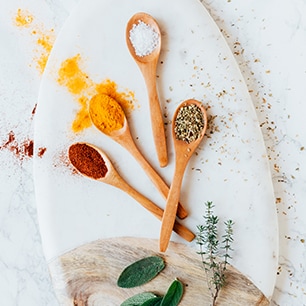It’s time to start thinking about what to serve your guests for upcoming holiday gatherings. We all have our go-to, traditional recipes that we prepare year after year. This holiday season, change it up with dishes inspired by international culinary traditions that add unique and unexpected flavors. Many of the spices you use can help you reduce added sugar, salt, and fat—keeping your menu in tune with your health goals.

Spices Are Nice. Herbs Are Superb.
Spices and herbs can transform a meal by adding a range of flavors, from a hint of sweetness to a kick of heat. Try the following strategies for using spices and herbs to create flavorful, fulfilling dishes without all the added sugar, salt, and fat.1
- Instead of sugar, add spices such as cinnamon, nutmeg, and vanilla to enhance the sweetness and flavor. You can reduce the sugar by up to 50% in most recipes.
- Replace the salt with savory flavors such as black pepper, garlic powder, curry powder, cumin, basil, ginger, coriander, and onion.
- Reduce the fat by a third from most recipes without affecting the flavor. For example, if a recipe calls for 3 tablespoons of oil, use 2 tablespoons—this will cut about 100 calories and 10 grams of fat.2
Fresh vs. Dried Herbs and Spices
What if your recipe calls for fresh herbs and all you have are dried ones? Use this reference to convert them.
1 tablespoon finely cut fresh herbs = 1 teaspoon crumbled dried herbs = 1/4 to 1/2 teaspoon ground dried herbs
Timing Is Everything
Make the most of your spice and herb flavor by knowing when to add them to your recipe, which often depends on preparation style.
Fresh – As a general rule, add fresh herbs and spices near the end of the cook time or just before serving. Adding them too soon may cause the flavor and aroma to diminish.
Dried – Add dried herbs and spices during cooking, keeping in mind the following tips.
- Whole dried spices and herbs (e.g., allspice and bay leaves) are ideal for dishes that cook for an hour or more, such as soups and stews.
- When adding ground dried spices and herbs, keep in mind the cook time and type of herb. For shorter cook times, add them at the beginning; for longer cook times, add them at the end. Add milder herbs (e.g., basil) near the end and robust herbs (e.g., thyme) earlier.
For uncooked foods, such as salads, add both fresh and dried spices and herbs several hours before serving to allow the flavors to blend. 2
Our Publix registered dietitian nutritionists have worked with our Publix chefs to create delicious, internationally inspired spice blends and recipes for your holiday menu. Scroll through our many possibilities for incorporating the global culinary traditions you enjoy.
(Source: Publix)
Be sure to look for Publix and GreenWise spices on our baking aisle. Seasoning blends, such as Italian, Cajun, and garam masala, are also available.
Discover more Publix recipes by cuisine, including Cajun/Creole, Italian, Mexican, Latin, Indian, and others.
Sources
1 Mayo Foundation for Medical Education and Research (MFMER). "Recipe makeovers: 5 ways to create healthy recipes." Mayo Clinic. August 10, 2016.
2 Henneman, Alice, MS, RD. "Add a Little Spice (& Herbs) to Your Life!" University of Nebraska–Lincoln Institute of Agriculture and Natural Resources. Accessed September 25, 2018.

 You are about to leave publix.com and enter the Instacart site that they operate and control. Publix’s delivery and curbside pickup item prices are higher than item prices in physical store locations. Prices are based on data collected in store and are subject to delays and errors. Fees, tips & taxes may apply. Subject to terms & availability. Publix Liquors orders cannot be combined with grocery delivery. Drink Responsibly. Be 21. For prescription delivery, log in to your pharmacy account by using the Publix Pharmacy app or visiting
You are about to leave publix.com and enter the Instacart site that they operate and control. Publix’s delivery and curbside pickup item prices are higher than item prices in physical store locations. Prices are based on data collected in store and are subject to delays and errors. Fees, tips & taxes may apply. Subject to terms & availability. Publix Liquors orders cannot be combined with grocery delivery. Drink Responsibly. Be 21. For prescription delivery, log in to your pharmacy account by using the Publix Pharmacy app or visiting 

